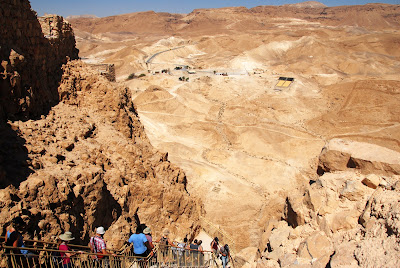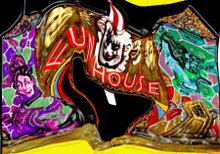Masada!
Masada is an absolutely stunning archaeological site and I was excited to see it!
Unfortunately it was also where the politics of narrative became a bit threadbare. I was becoming disillusioned by the stories I had heard at the kibbutzes of how things had been changing since the 1960s. I understand that the world had gone this way and it should not surprise me that the egalitarian values of the kibbutz had also degraded over the years, but it became clear to me that human nature is such that doing the right thing was not a good enough motivation to keep a community going. Over the years some kibbutzeem began to pay people different amounts for different jobs, to build bigger homes for certain people and to sell homes on their land to those who wnated to pay the price, all of which worked against the ideals of the earlier ideological kibbutzeem.
Masada is all about the sacrifices that it was felt were necessary to maintain the home land, but it was also a sacrifice of one kind of integrity to maintain one of a different kind.
The story that we have handed down of Masada is indspirational. A Jewish community holds out despite impossible odds against a Roman seige until the bitter end, deciding when the situation becomes hopeless to take their own lives rather than lose their freedom. This is the stuff of Hollywood film (and we have indeed seen it in Hollywood played out by a grimacing Peter O'Toole and the dashingly handsome Peter Strauss).
The fortresses are at the top of a horst - basically a very tall mesa that has an uneven top. Visitors can either hike the strenuous snake path up the mountain, or take the cable car.
This is a series of shots taken as the cable car got higher and higher.
Those little rectangles below are where the Roman camps that lay seige to the fortresses were.
The picture below shows how incredibly far up the fortresses were. One of the things that is so incredible about the Roman seige is that they built a ramp of rocks and earth so they could assault the fortress. This ramp was some 375 feet (114meters) high and must have stretched for miles.
There are numerous buildings at the top constructed and or remodeled by Herod the Great in 37 - 31 BCE if we can trust the account of Josephus Flavius. Below is a model of the buildings including a cascading fortress down the side facing the camera.
There are quite a few structures left above. Josephus reports that when the Romans finally broke through and achieved their goal, they found that the Siicari rebels (a radical group of Jewish rebels) had set fire to the palace and committed mass suicide.
The uppermost level was full of storerooms and cisterns.
The palace/fortress that cascades down from the top of the horst is an amazing feat of architecture.
We had to descend down a very steep path to get to these structures.
I was told the white area is the place where the Romans began to build their ramp. The rebels must have felt they were very safe at first but then been dismayed as every day the thousands of men (soldiers, slaves, prisoners estimated at 15,000) employed by the Romans built the ramp a little higher and closer.
The remains of those palaces were stunning and there was even color remaining on the walls behind the well preserved pillars.
Of course having descended down the cliff side to get to the palaces, we had to climb back up again to see the rest of the complex. Luckily there was a little shelter where we could take a rest and talk a bit about what we knew from the archaeology versus what was reported by Josephus. Josephus had overestimated the height of the horst and reports on only one fortress when there were clearly two at the time period of the Seige (73CE). He also claims that 960 people committed suicide, but we have remains of only 28 bodies. These were found primarily at the foot of the horst and were found mingled with pig bones, which makes it seem unlikely that these are the bodies of the Jewish rebels. Pigs were often sacrificed by the Romans in burial practices and so it is possible that these were Roman bodies.
Josephus does tell a mesmerizing and dramatic story, but we have little to actually support what he says. This doesn't mean that the stories are not true. It simply means we don't know the extent of the accuracy. Unfortunately that is not how the story of Masada is now being told. It has become political fodder for a form of hyper-nationalism and is resented as unimpugnable truth. We were criticized by an official guide for having skipped the "educational movie" at the entrance of the park. Out of curiosity I went back and watched it and was rather dismayed by the hyperbole of the footage which praises the rebels (who according to Josephus were actually a ratyher ruthless faction of radicals who felt things weren't progressing fast enough. They were not necessarily representative of the values of the rest of the Jewish community of the time or even of those who rebelled.) Josephus is omewhat ambivalent about the Sicarii (rebels) - who had splintered off from the Zealots who were involved in the revolt. (The Sicarii according to Josephus, for example, raided a Jewish camp and killed 700 women and children to arouse anger.) The film presents the Sicarii as unquestionable patriots asking us whether we ourselves would have chosen death (freedom) or slavery and then at the end tells us it is now time to climb the mountain.
Clearly this is a very useful myth in terms of securing loyalty and emotional attachment to a frequently persecuted culture, and an ethical argument can be made that bending the facts (or at least what is known) may be okay because the results are so important, but to me this feels very manipulative and not in keeping with the spirit of religious law. The Talmudic tale of Rav Safra suggests we shoudl do what is in our heart. Safra was reciting his prayers when someone made an offer to purchase something. Becuase he was busy he did not reply and the prospective buyer took this as a sign that he needed to offer more money even though Safra would have taken the initial offer if he had not been praying. When he finished praying, the Rabbi insisted on taking the original offer to which he had consented "in his heart". While in others' hearts the love of the homeland no doubt makes it seem just fine but in my heart the exaggerated emotional appeal without supporting facts does not feel right and I cannot even begin to analyze the connection between the truth, the heart and the mind, but to me it did not feel good.
Josephus does tell a mesmerizing and dramatic story, but we have little to actually support what he says. This doesn't mean that the stories are not true. It simply means we don't know the extent of the accuracy. Unfortunately that is not how the story of Masada is now being told. It has become political fodder for a form of hyper-nationalism and is resented as unimpugnable truth. We were criticized by an official guide for having skipped the "educational movie" at the entrance of the park. Out of curiosity I went back and watched it and was rather dismayed by the hyperbole of the footage which praises the rebels (who according to Josephus were actually a ratyher ruthless faction of radicals who felt things weren't progressing fast enough. They were not necessarily representative of the values of the rest of the Jewish community of the time or even of those who rebelled.) Josephus is omewhat ambivalent about the Sicarii (rebels) - who had splintered off from the Zealots who were involved in the revolt. (The Sicarii according to Josephus, for example, raided a Jewish camp and killed 700 women and children to arouse anger.) The film presents the Sicarii as unquestionable patriots asking us whether we ourselves would have chosen death (freedom) or slavery and then at the end tells us it is now time to climb the mountain.
Clearly this is a very useful myth in terms of securing loyalty and emotional attachment to a frequently persecuted culture, and an ethical argument can be made that bending the facts (or at least what is known) may be okay because the results are so important, but to me this feels very manipulative and not in keeping with the spirit of religious law. The Talmudic tale of Rav Safra suggests we shoudl do what is in our heart. Safra was reciting his prayers when someone made an offer to purchase something. Becuase he was busy he did not reply and the prospective buyer took this as a sign that he needed to offer more money even though Safra would have taken the initial offer if he had not been praying. When he finished praying, the Rabbi insisted on taking the original offer to which he had consented "in his heart". While in others' hearts the love of the homeland no doubt makes it seem just fine but in my heart the exaggerated emotional appeal without supporting facts does not feel right and I cannot even begin to analyze the connection between the truth, the heart and the mind, but to me it did not feel good.
As we discussed the complexities of the site, these birds watched us.
Since the Romans were in Masada, there was a bath complex.
Again we have remnants of fresco along with the signs that we had a heated bath or calidarium.
This particular bath had windows with window panes.
Large sheets of quartz had been fitted over the windows and let in a warm, hazy light
Here are those same windows from the outside.
In this close up you can see the "window panes" .
There were many buildings and interesting things to see here. There were gates and a synagogue and even a place on the mountain where you could hear a really cool echo.
In one of the buildings a man was copying the Torah by hand.
The picture below shows the water system that the Romans designed for the area. You could pour water in the top and see how water was routed throughout the whole site.
These structures were Dovecotes. The manure was collected and used in farming (and according to Cassius was some of the best manure for that purpose).
Below are a few more random buildings.
This was one of the most interesting sites that we visited and I could easily have spent more time there. When we were done we went back to the Resort and some of us decided to go down and experience the Dead Sea.
The Dead Sea is 40% salt and it makes one incredibly buoyant.
It was a very full day, and I was sad that we would be leaving our wonderful resort home on the next morning. I was however looking forward to seeing Jerusalem.


































No comments:
Post a Comment